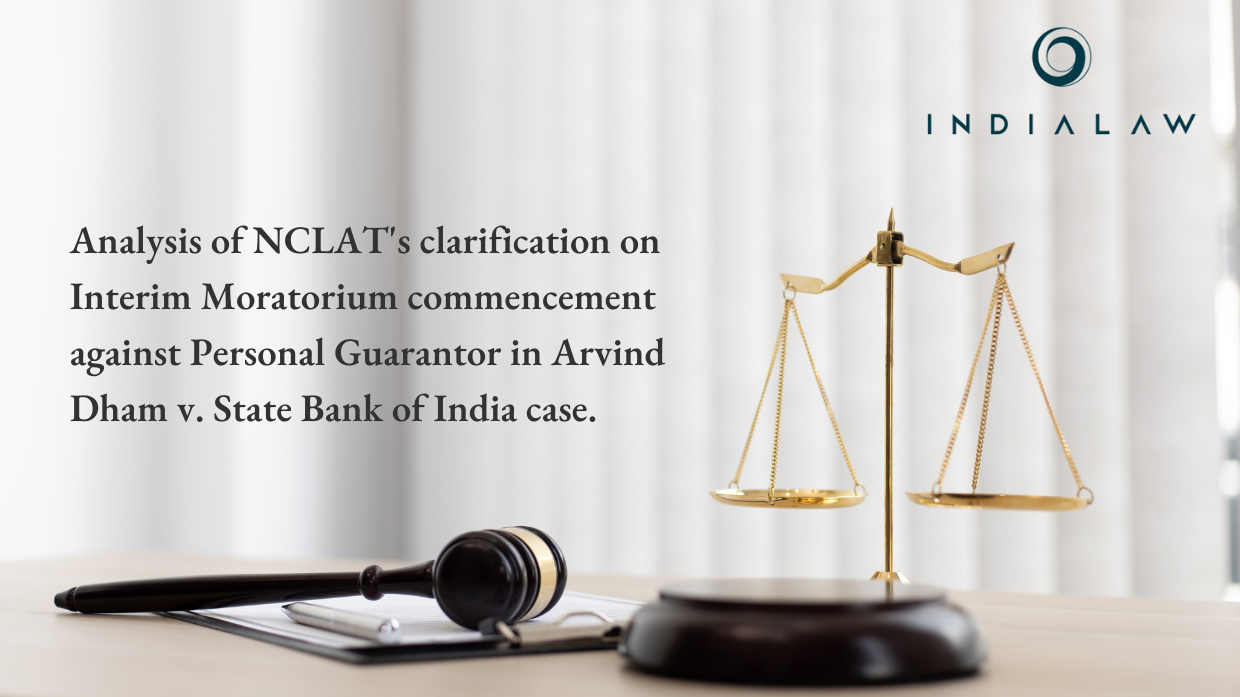“NCLAT clarify when Interim moratorium commences against the Personal Guarantor, If Section 95 Application is not filed before proper jurisdictional NCLT” – An Analysis of the Mr Arvind Dham v. State Bank of India and Anr. Case.

Introduction:
The case of Mr Arvind Dham v. State Bank of India and Anr. revolves around the admission of Section 95(1) application filed by the State Bank of India against the appellant, Mr Arvind Dham, by the Adjudicating Authority (National Company Law Tribunal), New Delhi. The appeal challenges the order dated 28.02.2024, wherein the Section 95(1) application was admitted under Section 100 of the Insolvency and Bankruptcy Code (IBC). The key issue at hand is whether the application filed by the State Bank of India was maintainable and whether it was barred by limitation.
Table of Contents
Facts of the case:
In the case of Mr. Arvind Dham v. State Bank of India and Anr., the appellant provided personal guarantees to two corporate debtors, Castex Technologies Pvt. Ltd. and Stride Auto Parts Ltd., in favor of L&T Finance Ltd. and State Bank of India, respectively, to secure their debts. The National Company Law Tribunal (NCLT), Chandigarh, admitted a Section 7 application filed by State Bank of India against Castex Technologies Pvt. Ltd. on 20.12.2017, while a Section 9 application filed against Stride Auto Parts Ltd. was admitted by NCLT, New Delhi, on 08.01.2019. Subsequently, L&T Finance Ltd. filed a Section 95 application against the appellant before NCLT, New Delhi, on 23.01.2020. State Bank of India also filed a Section 95 application against the appellant before the Adjudicating Authority on 21.10.2020. On 06.04.2022, L& T Finance Ltd application under Section 95 filed before NCLT, Delhi was dismissed as withdrawn. On 28.02.2024, the Section 95 application filed by State Bank of India was admitted after considering the report submitted by the Resolution Professional and objections raised by the appellant.
Contentions by Both Sides:
The contentions presented by both sides in the case of Mr Arvind Dham v. State Bank of India and Anr. revolve around the jurisdiction of the application filed by the State Bank of India under Section 95(1) of the Insolvency and Bankruptcy Code (IBC), as well as the issue of whether the application was barred by limitation.
The Appellant argued that the application filed by L&T Finance Ltd. under Section 95 before the National Company Law Tribunal (NCLT), New Delhi, on 23.01.2020, triggered an interim moratorium as per Section 96 of the I&B Code. Therefore, according to the Appellant, no other creditor, including the State Bank of India, had jurisdiction to file any proceeding, including an application under Section 95. Additionally, the Appellant contended that the application filed by the State Bank of India on 20.10.2020, before the NCLT, New Delhi, was without jurisdiction due to the interim moratorium triggered by L&T Finance Ltd, earlier application. Furthermore, the Appellant argued that the application by the State Bank of India was barred by limitation, as the debt default occurred on 29.12.2016, and the application was filed after a period of three years.
On the other hand, the State Bank of India refuted the Appellant’s arguments by asserting that the application filed by L&T Finance Ltd. was without jurisdiction. They argued that since a Section 7 application had already been filed against Castex Technologies Pvt. Ltd. before NCLT, Chandigarh, any application against the personal guarantor should have been filed there as well. State Bank of India contended that the application filed by L&T Finance Ltd. at NCLT, New Delhi, lacked jurisdiction and was subsequently dismissed as withdrawn on 06.04.2022. Therefore, they argued that their application before NCLT, New Delhi, was maintainable. Furthermore, the State Bank of India asserted that their application was not barred by limitation, as they issued a notice to the Appellant on 24.09.2018, well within three years from the date of default. They also pointed out that the demand notice under Section 95 was issued on 19.08.2020, within the permissible timeframe.
Observations of The National Company Law Appellate Tribunal:
The National Company Law Appellate Tribunal (NCLAT) observed that the application by L&T Finance Ltd. was filed without jurisdiction, as per Section 60(2) of the IBC. It noted that since the Section 7 application against Castex Technologies Pvt. Ltd. was pending before NCLT, Chandigarh, any application against the personal guarantor should have been filed there. Therefore, the interim moratorium under Section 96 did not kick in. The NCLAT also emphasized that an order passed by a court without jurisdiction is nullity. Furthermore, it cited precedents to support the principle that when proceedings against the corporate debtor are pending, any application against the personal guarantor should be filed in the same adjudicating authority. NCLAT cited the judgment of the Hon’ble Supreme Court in State Bank of India vs. V. Ramakrishnan, (2018) 17 SCC 394 to support its interpretation of Section 60(1) and 60(3) of the Insolvency and Bankruptcy Code. This judgment was invoked to establish the principle that when proceedings against the corporate debtor are pending before an adjudicating authority, any application under Section 95 against the personal guarantor should be filed in the same adjudicating authority.
Regarding the limitation argument, the NCLAT found that the application by the State Bank of India was well within time.
Conclusion:
The National Company Law Appellate Tribunal dismissed the appeal filed by Mr. Arvind Dham challenging the order of admission passed by the Adjudicating Authority under Section 100 of the Insolvency and Bankruptcy Code. The NCLAT reaffirmed that the application filed by the State Bank of India under Section 95(1) was rightly admitted, emphasizing that the jurisdiction of such applications should align with the adjudicating authority where proceedings against the corporate debtor are pending, as per Sections 60(1) and 60(2) of the IBC. Furthermore, the NCLAT rejected the contention of the Appellant regarding the application being time-barred, highlighting that notices were issued well within the statutory timeframe. By upholding the jurisdictional integrity and timeliness of the application, the NCLAT underscores the adherence to legal principles and procedural fairness in insolvency proceedings. Therefore, the dismissal of the appeal signifies the affirmation of the Adjudicating Authority’s decision and upholds the integrity of the insolvency resolution process under the IBC.
By entering the email address you agree to our Privacy Policy.



